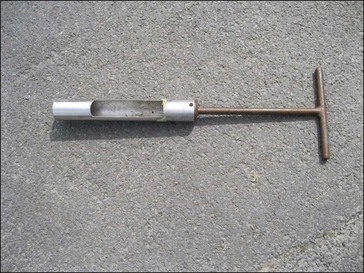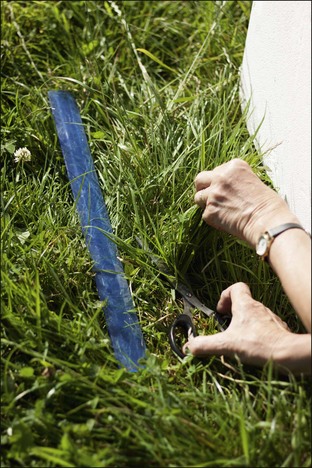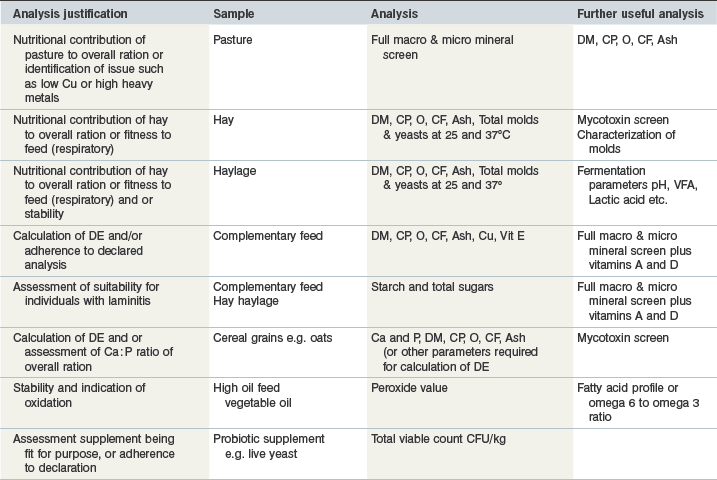23 Ration evaluation and formulation
Information needed for ration evaluation
Predicted versus actual analysis
Laboratory analysis of feed and forage samples
Assessment of forage consumption
Assessment of grazing consumption
Matching intake to requirements
Establishing forage intake and a suitable forage to concentrate ratio
Advantages, disadvantages/limitations of various manufacturing processes
Information needed for ration evaluation
There is a range of information that must be gathered in order to practically evaluate a current ration or indeed formulate a new ration, all of which will be discussed in this chapter including the factors mentioned in Box 23.1.
Box 23.1
Information Required for Ration Formulation Includes the Following
Factors associated with the horse
| Age | Young growing, mature, or aged |
| Physiological state | Pregnant, lactating, growing, body condition (overweight, ideal or underweight), presence of nutritionally related disease, behavior-related issues. |
| Activity | Maintenance, level of exercise, type of exercise |
| Preferences | Horses may have a preference for a particular feed type |
Factors associated with the feed
| Dietary history | Nature, amount and analysis of current ration |
| Chemical composition | Sensory evaluation (e.g., indication of type of hay) |
| Laboratory analysis | e.g., protein, oil and fiber content and calculation of energy content |
| Hygienic quality | Sensory and/or laboratory analysis |
| Feedstuffs availability | There will be regional variation in the availability of different feedstuffs |
Integrity of the information
• Lack of knowledge of the actual feeds used or feeding management in place by the owner or trainer, especially where they are not responsible for the feeding on a day to day basis.
• Lack of appreciation of differences in the quality or availability of grazing or variability of forage type or quality.
• Inaccurate assumptions regarding horse factors, e.g. the level of physical activity is often over-estimated.
• Inaccurate assumptions about the weight of feed fed and differences in density– this is reflected by the common reference to the proverbial “1 lb scoop” or coffee can.
• Inaccurate assumptions regarding the chemical composition of feeds.
• Poor reflection of forage intake including inaccurate statements such as ad libitum feeding of forage.
• Failure to account for wastage of either concentrate feeds or forage.
Predicted versus actual analysis
Nutrient analysis of forage, for example alfalfa, can vary considerably depending on factors such as stage of growth at harvest, type of grass, fertility of the soil as well as the soil type and underlying geology of the land (Van Soest et al 1978). All of these factors will also affect the nutrient content of pasture. Whilst historical pasture analysis is sometimes available during ration evaluation, it is usually restricted to large professional establishments. It is therefore more common for a nutritionist to draw on published nutrient values for pasture and forage (NRC 2007), which introduces inherent inaccuracies. Localized regions of pasture inadequacy in trace minerals such as copper, for example in parts of Ireland, or extreme reductions in pasture quality (e.g., in UK moorland) may not be captured.
Key Points
• Information pertaining to the horses’ current physiological state is essential
• Previous dietary history is an extremely important part of ration evaluation
• Maintaining the integrity or accuracy of gathered information regarding the horse/horses, where ration is being evaluated, as well as the nature of the current ration will improve the evaluation process
Assessment of current ration
Energy content of feeds and forages
The energy content of feeds and forages must be obtained for accurate ration analysis, either through the use of predicted values or calculation from proximate analysis using published equations. The energy value of feeds can also be derived in vivo from feeding trials, although this would usually be beyond the scope of practical ration evaluation. Energy, which is usually described in terms of either joules (e.g. in Europe) or calories (e.g. in USA [1 kcal = 4.184 kJ], is most often expressed as digestible energy (DE), although in Europe net energy (NE) or derivatives thereof as discussed in Chapter 4 are routinely used).
There are a number of published equations that can be used to calculate the DE or UFC content of feedstuffs from their chemical composition which have been previously reviewed (Harris 1999) and are summarized below. The energy value assigned to a feed, whether estimated or calculated, must always be in the same format as the target energy requirements, for example DE for NRC requirements (NRC 2007), UFC for INRA requirements. See Box 23.2.
Box 23.2
Example of Equations Used to Determine DE and UFC from Feed Chemical Composition (see also Chapter 5)
CC = cytoplasmic carbohydrate; CP = crude protein; DCP = digestible crude protein; ADF = acid detergent fiber; NDF = neutral detergent fiber; CF = crude fiber; DCF = digestible crude fiber; NSc = 100 − CP − EE − NDF − ash; DEE = digestible ether extract; DNFE = digestible nitrogen free extract.
Forage and feed sampling
Forage sampling
Forage samples should ideally be taken using a hay bore, which consists of a long metal cylinder that can be inserted to a given depth into a bale of hay, haylage or straw usually driven by an electric drill (Fig. 23.1). In this manner, several samples can be taken from many bales to build up a representative mixed sample of a particular batch of forage. Where possible the sub-samples of hay should be mixed but there is also a reliance on the laboratory to resample for analysis in an appropriate way. Bales of haylage should be carefully re-sealed following sampling to avoid aerobic spoilage. Where a hay bore is not available, simple grab samples can be used to give an estimate of forage analysis, but again multiple samples should be taken from multiple bales from varying regions and depths within the bale where possible as this will require bales to be opened. In instances where forage is suspected of contributing to health issues such as colic or sporadic respiratory disease it may be necessary to establish the variability in nutritional value or quality of the forage. In this instance many single bales may need to be analyzed, with composite samples being taken from each individual bale.
For haylage, samples should be placed into sealed bags, expelling the air as far as possible prior to sealing. This is particularly important where fermentation characteristics or microbiological analysis of haylage is required. Due to the variable instability of haylage, once removed from their anaerobic environment (Cecilia 2009), samples of haylage should always be shipped to the laboratory immediately. Ideally, these should be sent on a next day delivery service, avoiding the possibility of haylage samples remaining in the post or being unprocessed over a weekend.
Complementary feed assessment and sampling
• Open a bag of feed by cutting open down both sides and open up the bag completely.
• Using a clean scoop or shovel mix the contents of the bag thoroughly.
• Wearing latex gloves or using an inverted plastic bag take 10–12 samples of the feed bag covering all areas of the spread feed into a single clean sample bucket or bag to form a composite sample.
• Repeat this process with up to 10% of the total feed batch.
• Thoroughly mix the composite sample and then take two representative samples.
Assessment of vitamin–mineral and specialized supplements
Feed supplements can also be analyzed for adherence to their specification, in order to ensure that they contain the declared level of active ingredients. This is particularly important where a product is reputed to help maintain an aspect of health e.g. the reputed ability of a product to support joint health may depend on the level of particular active ingredients being present. Previously glucosamine-containing oral joint supplements have been shown to have poor adherence to their declared specification in terms of the amount of this active ingredient they contained (Oke et al 2006). In this study, of the products analyzed, 39% were shown to contain less glucosamine than claimed by the manufacturer and 17% had less than 30% of the amount claimed. It is also not uncommon for specialized supplement ingredients to exhibit a reduced or even absent level of the bioactive substance, (e.g., harpagosides, which are the active ingredient in Devils claw; Dunnett 2010).
Assessment of pasture
Pasture sampling should be carried out using an established format, which may include walking a large “W” or “M” within each paddock and cutting representative samples of grass at numerous points. Areas of heavy contamination with urine or dung should be avoided and in order to minimize soil contamination samples should not be cut too close to the ground or pulled rather than cut (Fig. 23.2). Additionally samples should ideally be taken on dry days to avoid soil contamination from splash back. Further details on pasture sampling procedures and precautions have been previously provided (MacNaeidhe 1995).
Laboratory analysis of feed and forage samples
The analysis requested from the laboratory will depend on what information is required and the specific ration evaluation questions being asked. For example, analysis may be undertaken in order to assess the suitability and/or quality of a particular batch of forage, or a feed mix may be analyzed to enable calculation of a DE value. Alternatively laboratory analysis of a proprietary feed may be required to check for adherence to the declared analysis or typical analysis provided by the manufacturer. Individual raw materials may be analyzed so that they can be added to a database enabling the formulation of proprietary feeds or a ration of straights. “Straights” are a colloquial term that refers to a mixture of straight feeding stuffs such as oats, barley, alfalfa, sugar beet, etc. that can be mixed to provide a complementary or concentrate feed for horses. Table 23-1 gives examples of some of the analytical profiles that could be requested for different situations.
Assessment of forage consumption
Assessment of forage intake requires a record of both the weight of forage offered, which can be easily achieved when horses are fed individually, but is more problematic in group fed animals. Wastage of forage should also be recorded in order to increase accuracy. Wastage of forage can be particularly high in performance horses (Geor 2005), that may self-limit forage intake when a high level of energy rich concentrate feed is fed. Where hay is soaked or steamed, the weight offered should be recorded prior to such treatment.
Assessment of grazing consumption
For horses or ponies that spend time at pasture, an assessment of grass intake must be made. This is often problematic and represents a significant area for inaccuracy within the overall ration evaluation, both in terms of energy and macro- and micronutrient intake. However, if the animal is maintaining bodyweight when out at pasture (or being fed conserved forages) this reflects adequate energy intake. In contrast, animals increasing or losing bodyweight in such circumstances may have access to too much or too little pasture or forage, respectively. This may be due to factors such as herbage yield, stocking density, etc. or may reflect a clinical issue. This is of course more significant in animals where grass represents a significant portion of their diet including brood mares, leisure horses or ponies and endurance horses. Voluntary dry matter intake (VDMI) will be influenced by grazing behavior, which can be affected by a number of factors such as quality and quantity of grazing, gender, age, breed, breeding status and also whether the animals are at grass in isolation or with a group. This has been reviewed extensively in Chapters 3 and 18, and also previously (NRC 2007). The effect of forage quality on voluntary intake is not simple in horses and appears to vary between individuals with some increasing and others decreasing their voluntary intake in response to a reduction in forage quality and dry matter digestibility (Edouard et al 2008). The effect of sward height was more straightforward, with horses choosing grass with a higher sward when patches are of an equal quality (Edouard et al 2009), presumably to maximize intake.
Whilst it is recognized that the rate of intake of pasture is commonly affected by body size and mouth morphology in other mammals, the effect in horses and ponies has only recently been reported to conform to this model. Ponies appear to be able to increase their rate of consumption by increasing bite size; however, their overall intake seems to be limited by the maximum achievable processing speed (the time taken to bite and masticate), which is greater in larger horses as it increases with body size (Fleurance et al 2009).
Ultimately, dry matter intake of horses and ponies at grass, which is discussed in greater depth in Chapter 18, can vary widely between individuals and most estimates suggest a range of between 1.6–3.6% of bodyweight (NRC 2007) with lactating mares typically at the higher end of this range for VDMI (2.6–3.1%). Ponies are estimated to have a high VDMI in comparison to horses, which may approach 5% of body weight when stabled and provided with ad-libitum fiber based complete feed. Ponies also appear to have the capability to consume a high proportion of their predicted VDMI in a relatively short period of time when grazing time is restricted (Dugdale et al 2011). It has been reported that ponies are capable of ingesting nearly 50% of their total daily dry matter intake during only 3 hours of grazing (Ince et al 2011).
In young horses (yearlings and 2-year-old Salle Francais breed), intake relative to metabolic bodyweight was 82 g OM/kg LW0.75/day and did not vary with age. However, the 2-year-old horses exhibited a reduced foraging time and a higher rate of intake (Pascal et al 2000).
Matching intake to requirements
Assessment of energy and micronutrient intake
Once all of the information regarding feed intake and analysis of feeds and forage has been gathered, the task of assessing the ability of the ration to satisfy daily requirements for a particular horse or group of horses begins. Other information such as age, body condition and level of exercise undertaken as well as breeding or growth status must of course also be established. Whilst difficult to quantify, environmental influences on energy requirement should not be ignored (Cymbaluk & Christison 1990).
Bodyweight and condition
There is a lack of awareness of body condition and also some resistance amongst horse owners to accept that horses or ponies are overweight, leading to inaccuracy of owner assessment (Wyse et al 2008). Body weight can be assessed easily where there is access to a weighbridge, or alternatively an estimation of bodyweight can be made using measurements of heart girth, length, and wither height (Carroll & Huntington 1988). A number of commercially available weigh tapes are also available, which simplifies this process. A good correlation exists between bodyweight calculated using a weight tape in comparison to that measured on a weighbridge (Ellis & and Hollands 1998). However, weigh tapes may be more useful for determining differences in bodyweigh over time for individual animals as their accuracy can be variable. In addition, this method is less useful in pregnant mares, growing horses, very fit as well as extremely thin or fat animals, as discussed in Chapter 22.
Body condition score should also be assessed and there are a number of scoring systems available. A condition score system can involve an overall assessment of the whole body according to an arbitrary scale of, for example, 1–5. Alternatively, condition score of different regions of the body, such as neck, withers, loin, tail head and ribs can be assessed in isolation and a mean condition score calculated accordingly. The latter method may be more robust where horses are not of a standard shape such as broodmares and horses in race training. However, in obese animals that require caloric restriction, changes in body condition may not always be apparent with initial weight loss as shown previously in ponies (Dugdale et al 2010, Henneke et al 1983). Body condition score should not be relied upon in isolation to trigger further caloric restriction and is therefore ideally used in conjunction with actual bodyweight. (Further recommendations can be found in Chapter 28.)
Stay updated, free articles. Join our Telegram channel

Full access? Get Clinical Tree





